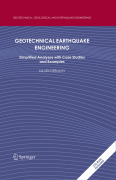
Geotechnical earthquake engineering: simplified analyses with case studies and examples
Srbulov, M.
This volume describes simplified dynamic analyses that bridge the gap betweenthe rather limited provisions of design codes and the rather eclectic methodsused in sophisticated analyses. Graphs and spreadsheets are included for the ease and speed of use of simplified analyses of: (1) soil slope (in)stability and displacements caused by earthquakes, (2) sand liquefaction and flow causedby earthquakes, (3) dynamic soil-foundation interaction, (4) earthquake motion effects on tunnels and shafts, (5) frequent liquefaction potential mitigation measures. A number of comments on the methods assumptions, limitation and factors affecting the results are given. Several case histories are also included in the appendices in order to assess the accuracy and usefulness of the simplified methods. Audience: Geotechnical engineers, engineering geologists, earthquake engineers and students. Practical (hands on) use for everyday designs and analyses by the engineers Simplified solutions for very complex problems ingeotechnical earthquake engineering Includes all major subjects of geotechnical earthquake engineering INDICE: From the contents Foreword. Preface. Acknowledgements. 1. Well known simplified models. 2. Soil properties. 3. Seismic excitation. 4. Slope stability and displacement. 5. Sand liquefaction and flow. 6. Dynamic soil – foundation interaction. 7. Bearing capacity and additional settlement of shallow foundation. 8. Seismic wave propagation effect on tunnels and shafts. 9. Comments on some frequent liquefaction potential mitigation measures. References. Appendices. Index.
- ISBN: 978-1-4020-8683-0
- Editorial: Springer
- Encuadernacion: Cartoné
- Páginas: 250
- Fecha Publicación: 01/11/2008
- Nº Volúmenes: 1
- Idioma: Inglés
